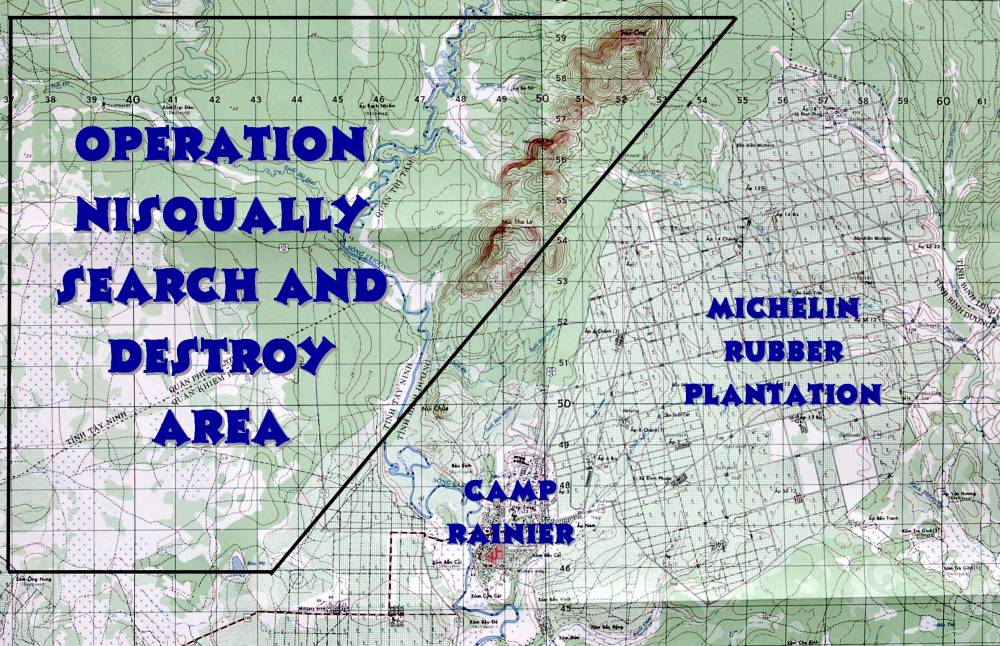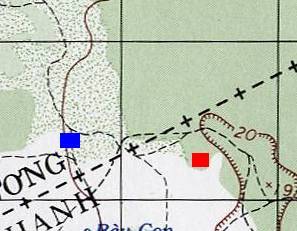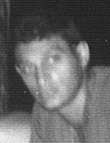BATTLE WHEN DONALD EVANS EARNED CMH FOR GALLANTRY
Friday, January 27th:
Operation Cedar Falls ended on January 26, turning Ben Suc into dust. All
civilians within the Iron Triangle were permanently resettled elsewhere,
producing a massive free fire zone. Eleven hundred bunkers, 400 tunnels and
500 other enemy structures were destroyed. The enemy lost 700 troops in that
raid and 300 were captured. They were not in a good mood. Neither were we.
By this time, our Company was taking casualties at an alarming rate. Some of
the men were in field hospitals from wounds received earlier. Yet, no
replacements had arrived. They were coming later. On January 28, I wrote home
that eight new men came into our Company.
On the morning of January 27, the 2/12 Infantry Battalion, after spending the
night in the area circled red on the lower map, was preparing to search out and
destroy the enemy operating in the open areas west of the Michelin. The 3/22nd
was working the area in the foothills north of the plantation. Both Units were
conducting their searches as part of Operation Fort Nisqually, the ongoing
drive to secure Camp Rainier.
Our region was well known by intelligence officials as a district heavily
occupied by local Vietcong and that it would be heavily contested. In fact,
the site of our battle was less than 2 kilometers from where Operation
Attleboro originated.

Henry Osowiecki, Porter Harvey and Larry Walter recounted the story of what
took place on that day. I have details that I secured from the Brigade
Situation Report. It is surprising how little is recorded from that day. Just
another day in the jungle.

At
7:40 AM, A Company began their search through the marshy area that features
vast areas of high grass surrounded by jungle. Not the type of terrain to
please an infantryman.
Porter Harvey, shown left, thought that the area was more prairie-like. The
pace set that day made him think that the Company was being pushed hard to
reach some undeclared objective. They spent the day in open fields moving
through one clearing to the next.


Firefight Locations on January 27
At 2:48 PM Alpha Company made contact with a group of 6 Vietcong at
coordinates XT 427512. (This location is marked on
the map by the blue box.) After a short firefight, the enemy disengaged
and melted into the jungle.
When I asked the men about this firefight, no one
recalled it. This is strange because the fight is recorded as resulting in two
A/2/12 men being wounded.
Wish I knew who
they were.
The Company resumed its march to the east in columns, with Second Platoon in
lead, followed by Third Platoon and the rest
of the Company behind.


Enlarged map of
battle site
This map illustrates the relative position of the columns as they approached
the area where the attack was about to take place.
 Henry Osowiecki, shown left, takes up the narrative as his platoon pushes
through the high grass
Henry Osowiecki, shown left, takes up the narrative as his platoon pushes
through the high grass
and notices a command helicopter
flying tree top level over the area.
“We were working through the clearings all day long.
The pace was demanding and we were looking forward to the end of the day
and a chance to rest.
Suddenly a chopper raced past us at low altitude. Shortly afterward, a
command was given to the Company to hang a left and enter the tree line. I
just knew that we would be making contact with the enemy and I was not
mistaken.
We swung our column to the left and slowly approached the jungle. It was
shortly after our lead men entered the tree line when a hail of gunfire and
grenades and once more, we were taking casualties from a bunker entrenched
enemy.”
An immediate call for a medic rang through the jungle. The second Platoon
Medic, a recent arrival in Country only a
week earlier, froze and refused to move into the withering fire that was
emanating from the front. This is not written to judge his behavior one way or
another, just to lay the groundwork for what was to happen later. I doubt that
there were many of us who did not hesitate or freeze a bit when an order was
given that represented something that was counter to our survival instincts.
 This
is where daring was needed and Doc Evans, shown left, the Third Platoon Medic,
responded to the challenge. Before his Platoon was committed to the battle, he
moved up into the fray. His heroics that day have become legendary, not only
to the men of Alpha Company, but also to the men of the entire 4th Infantry
Division. As a testimony of his actions on Jan 27, many years ago, Donald has
been honored with the Congressional Medal of Honor, (the first Medic to
receive one in the Vietnam Conflict and the earliest for the Fourth Division).
This
is where daring was needed and Doc Evans, shown left, the Third Platoon Medic,
responded to the challenge. Before his Platoon was committed to the battle, he
moved up into the fray. His heroics that day have become legendary, not only
to the men of Alpha Company, but also to the men of the entire 4th Infantry
Division. As a testimony of his actions on Jan 27, many years ago, Donald has
been honored with the Congressional Medal of Honor, (the first Medic to
receive one in the Vietnam Conflict and the earliest for the Fourth Division).
There were a number of brave incidents that took place on that afternoon.
Porter Harvey told me about an episode that occurred in the initial moments of
the firefight. There were many more that were recalled but this one came to
mind because of its boldness.
When
Second Platoon came under fire, John Faidley, from the Third Platoon, shown
right, 
passed by Porter moving up the line to help the Second Platoon that had taken
casualties and were trying to get them evacuated from the battle line. Porter
asked him why he was moving up to the fire before his platoon was committed.
John told him,” That’s where the bad guys are, aren’t they?” It would be the
last time that Porter saw John alive. No one who knew John will be surprised
to read this story. John was one of those soldiers whose instincts would
always lead him to where the action was taking place.
Finally, the Second Platoon was able to disengage and return to the clearing.
There was a short pause before a second push into the enemy base camp was
made. This time it was Third Platoon’s turn. The Platoon moved past the men of
Second Platoon who were busy administering to their wounded.
Slowly they entered the jungle and it was not long before enemy fire erupted
from their bunker line. They seemed even more prepared for us the second time
in as Third Platoon was picking up casualties even greater than the original
assault. It was during this time that three Alpha Company men were killed.
 John Faidley, Armand Aufiere, shown left, and Donald Evans gave their lives
trying to overtake the VC who were entrenched in that bunker line. All three
men were from the Third Platoon.
John Faidley, Armand Aufiere, shown left, and Donald Evans gave their lives
trying to overtake the VC who were entrenched in that bunker line. All three
men were from the Third Platoon.
Eventually, Third Platoon was ordered to disengage and got back the best that
they could. It became painfully clear that no infantry assault would succeed
in eliminating the heavily defended position.
It
was decided to have the Company move back a safe distance and have the air
force deal with the well-established base camp. It was not long before a
fighter arrived on scene and began spraying the enemy with a barrage including
40MM cannon fire. As was experienced the week before, the empty shell casings
rained on the troops. Most were extremely hot and it was not long before the
grass was ignited and a major brushfire had Alpha Company running for their
lives.
Finally, Alpha Company was a safe distance from the attack and was ordered
into a night position.
The men, overwhelmed by the action of the day, began preparing for the evening
in the field. According to what I was told, they were so spent by the day’s
action that they didn’t even set security. They pretty much crashed that night
and felt that they would deal with any situation as it arose. The night passed
without incident.
The next morning they arose and returned to the battle site of the day before.
When they arrived there, they were surprised by what they saw. The bunker
complex was destroyed, but nothing of any value was found. Once more, the
Vietcong left nothing on the field to reward the enemy for its sacrifices. It
was frustrating to the Company. They expected to receive casualties, but did
not expect the results to be so unrewarding.
During this day, the replacement troops I mentioned earlier were sent into the
field. I can only imagine what was crossing their minds as they were infused
into the different Platoons. It must have been something like, “Oh boy, what
did get myself into?”
That day passed without contact.
The following day the Company returned to Dau Tieng for some well-deserved
rest.
 Lt. Jim Olafson, left, who commanded the Company on the day of the last battle began
debriefing the troops for his report to HQ. The more information he received
of Donald Evans’ action that day, the more he realized that he needed to
recognize him for his heroics. He gathered the information and wrote out a
recommendation for a Silver Star for Valor. He submitted it to Brigade HQ and
was turned down and Jim was advised to resubmit it as a recommendation for a
Bronze Star. (Ed Smith, who worked at Brigade HQ before he became A/2/12
Company Commander told me that Colonel Garth was disturbed about the number of
medals being issued in Vietnam. This was reflected in the Brigade’s reluctance
in authorizing medals, especially upper level awards).
Lt. Jim Olafson, left, who commanded the Company on the day of the last battle began
debriefing the troops for his report to HQ. The more information he received
of Donald Evans’ action that day, the more he realized that he needed to
recognize him for his heroics. He gathered the information and wrote out a
recommendation for a Silver Star for Valor. He submitted it to Brigade HQ and
was turned down and Jim was advised to resubmit it as a recommendation for a
Bronze Star. (Ed Smith, who worked at Brigade HQ before he became A/2/12
Company Commander told me that Colonel Garth was disturbed about the number of
medals being issued in Vietnam. This was reflected in the Brigade’s reluctance
in authorizing medals, especially upper level awards).
Undeterred, Jim Olafson went back to the Company and reviewed Donald’s actions
of that day with the men in the Company. It became very apparent to him that
Donald’s actions were at a level beyond Silver Star worthy. He was right, of
course, and although it took better than a year to receive the authorization,
Donald Evans did receive the Congressional Medal of Honor, posthumously.
The citation read as follows:
CITATION:
For
conspicuous gallantry and intrepidity in action at the risk of his life above
and beyond the call of duty. He left his position of relative safety with his
platoon, which had not yet been committed to battle to answer the calls for
medical aid from the wounded men of another platoon, which was heavily engaged
with the enemy force. Dashing across 100 meters of open area through a
withering hail of enemy fire and exploding grenades, he administered
lifesaving treatment to one individual and continued to expose himself to the
deadly enemy fire as he moved to treat each of the other wounded men and to
offer them encouragement. Realizing
that
the wounds of one man required immediate attention,
SP/4 Evans dragged the injured soldier back across the dangerous
fire-swept area, to a secure position from which he could be further evacuated.
Miraculously escaping the enemy fusillade, SP/4 Evans returned to the
forward location. As he continued the treatment of the wounded, he was struck by
fragments from an enemy grenade. Despite his serious and painful injury he
succeeded in evacuating another wounded comrade, rejoined his platoon as it was
committed to battle and was soon treating other wounded soldiers. As he
evacuated another wounded man across the fire-covered field, he was severely
wounded. Continuing to refuse medical attention and ignoring advice to remain
behind, he managed with his waning strength to move yet another wounded comrade
across the dangerous open area to safety. Disregarding his painful wounds and
seriously weakened from profuse bleeding, he continued his lifesaving medical
aid and was killed while treating another wounded comrade. SP/4 Evans'
extraordinary valor, dedication and indomitable spirit saved the lives of
several of his fellow soldiers, served as an inspiration to the men of his
company, were instrumental in the success of their mission, and reflect great
credit upon himself and the Armed Forces of his country.
Donald Evans has inspired many US Army Medics over the last 40 years. His memory
has been honored at a number of major US Army installations. The two most
important are located at two American bases. The first is the magnificent
Evans Hospital
at Fort Carson. In 1986 the new base hospital at Fort Carson was named in
honor of Donald Evans. If you click here,
Donald's History
Page you will see some history that the hospital posted online relative to
Donald Evans.
Here are some pictures that Richard Evans, Donald's brother, shared with
me from that day:






 Henry Osowiecki, shown left, takes up the narrative as his platoon pushes
through the high grass
Henry Osowiecki, shown left, takes up the narrative as his platoon pushes
through the high grass This
is where daring was needed and Doc Evans, shown left, the Third Platoon Medic,
responded to the challenge. Before his Platoon was committed to the battle, he
moved up into the fray. His heroics that day have become legendary, not only
to the men of Alpha Company, but also to the men of the entire 4th Infantry
Division. As a testimony of his actions on Jan 27, many years ago, Donald has
been honored with the Congressional Medal of Honor, (the first Medic to
receive one in the Vietnam Conflict and the earliest for the Fourth Division).
This
is where daring was needed and Doc Evans, shown left, the Third Platoon Medic,
responded to the challenge. Before his Platoon was committed to the battle, he
moved up into the fray. His heroics that day have become legendary, not only
to the men of Alpha Company, but also to the men of the entire 4th Infantry
Division. As a testimony of his actions on Jan 27, many years ago, Donald has
been honored with the Congressional Medal of Honor, (the first Medic to
receive one in the Vietnam Conflict and the earliest for the Fourth Division).
 John Faidley, Armand Aufiere, shown left, and Donald Evans gave their lives
trying to overtake the VC who were entrenched in that bunker line. All three
men were from the Third Platoon.
John Faidley, Armand Aufiere, shown left, and Donald Evans gave their lives
trying to overtake the VC who were entrenched in that bunker line. All three
men were from the Third Platoon.  Lt. Jim Olafson, left, who commanded the Company on the day of the last battle began
debriefing the troops for his report to HQ. The more information he received
of Donald Evans’ action that day, the more he realized that he needed to
recognize him for his heroics. He gathered the information and wrote out a
recommendation for a Silver Star for Valor. He submitted it to Brigade HQ and
was turned down and Jim was advised to resubmit it as a recommendation for a
Bronze Star. (Ed Smith, who worked at Brigade HQ before he became A/2/12
Company Commander told me that Colonel Garth was disturbed about the number of
medals being issued in Vietnam. This was reflected in the Brigade’s reluctance
in authorizing medals, especially upper level awards).
Lt. Jim Olafson, left, who commanded the Company on the day of the last battle began
debriefing the troops for his report to HQ. The more information he received
of Donald Evans’ action that day, the more he realized that he needed to
recognize him for his heroics. He gathered the information and wrote out a
recommendation for a Silver Star for Valor. He submitted it to Brigade HQ and
was turned down and Jim was advised to resubmit it as a recommendation for a
Bronze Star. (Ed Smith, who worked at Brigade HQ before he became A/2/12
Company Commander told me that Colonel Garth was disturbed about the number of
medals being issued in Vietnam. This was reflected in the Brigade’s reluctance
in authorizing medals, especially upper level awards).